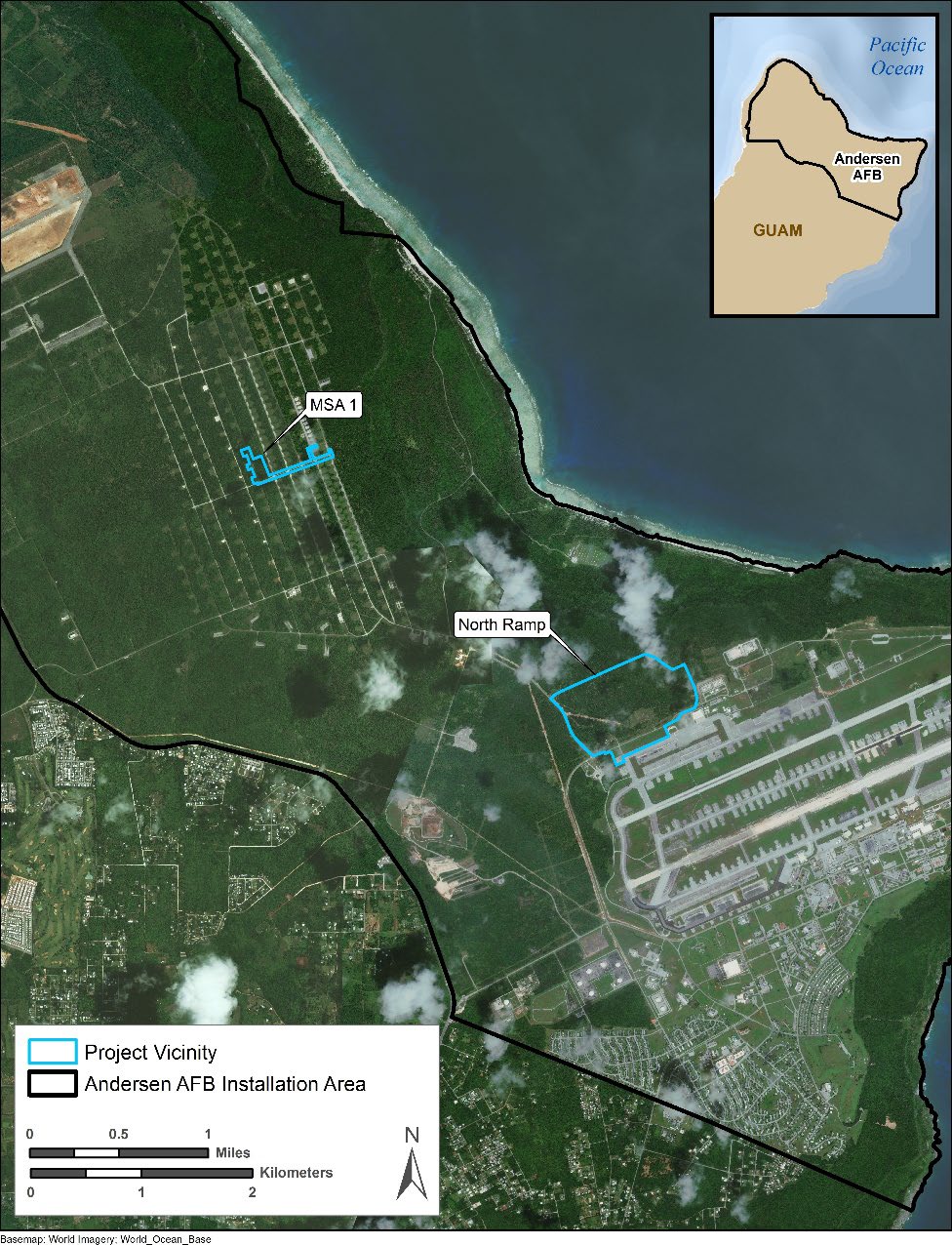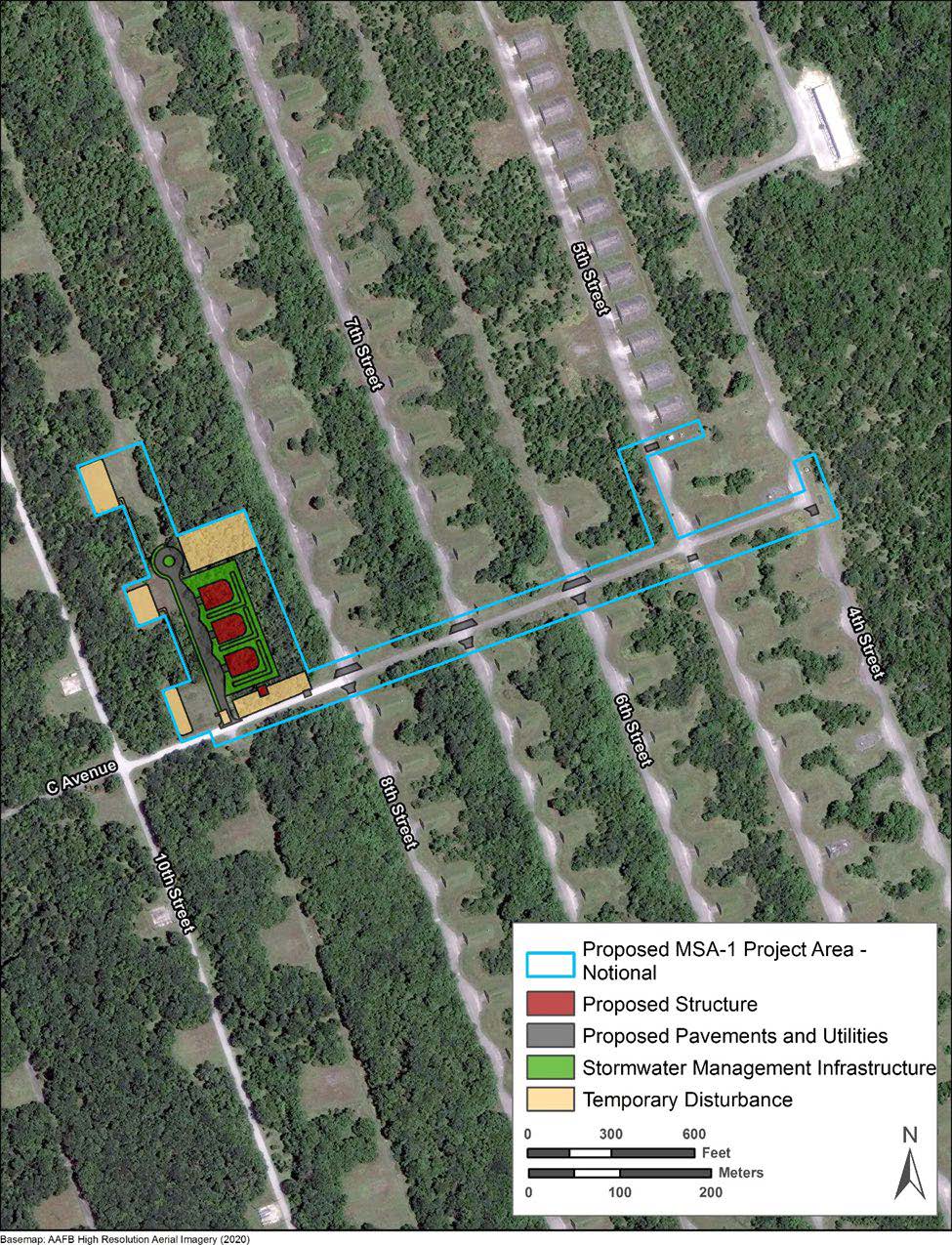AAFB Infrastructure EIS
About NEPA and EISs
The National Environmental Policy Act (NEPA) was enacted to address concerns about federal actions and their effects on the environment. An Environmental Impact Statement (EIS) is the most detailed analysis prescribed by regulations implementing NEPA.
About the Proposed Action
Background of the Project
The Department of the Air Force (DAF) and Department of Defense (DoD) strategic initiatives for the Indo-Pacific are continuously evolving in response to the geopolitical climate. The proposed Republic of Singapore Air Force (RSAF) F-15 beddown and mission support, and infrastructure upgrades at Andersen AFB would be conducted in alignment with evolving DAF and DoD strategies and initiatives for the Indo-Pacific region to modernize and strengthen DoD’s presence, as well as improve logistics and maintenance capabilities, and would allow the DAF and DoD to maintain agile defense capabilities within the region. In accordance with its responsibilities mandated by Title 10 U.S. Code 8062 to ensure readiness, the DAF proposes to augment and adapt its forward presence capabilities in alignment with DoD initiatives for deterrence and stabilization in the Indo-Pacific region.
Proposed Action
The Proposed Action includes the beddown and mission support of up to 12 RSAF F-15 fighter aircraft, and construction of infrastructure upgrades adjacent to the northwest
corner of the airfield (North Ramp) and in Munitions Storage Area-1 (MSA-1).
- F-15 Beddown: Beddown of up to 12 RSAF F-15 fighter aircraft with anticipated arrival in 2029, to include airfield operations and a 3 percent increase in installation personnel, which would strengthen partner nation alliances. Would include hosting periodic, temporary training events with support aircraft twice per year, for four weeks per event, in support of F-15 training mission requirements. No new airspace is proposed and no changes to the manner in which the existing airspace is used would occur.
- Infrastructure Upgrades: Construction of infrastructure upgrades over approximately 3 to 7 years at the North Ramp and within MSA-1 (Figures 2 and 3). Would provide additional options for parking, storing, maintaining, refueling, loading, and unloading aircraft at the airfield, as well as storing munitions. Could support both the F-15 beddown and other DAF, service component, and partner nation aircraft or missions operating from Andersen AFB now or in the future. Construction would disturb approximately 192 acres at the North Ramp and approximately 17 acres within MSA-1.
The Proposed Action is based on accommodating aircraft types and flight operations that have been addressed under previously prepared NEPA documentation for Andersen AFB, such as bombers, tankers, and fighters. Upgrading existing airfield and munitions infrastructure would allow Andersen AFB to better accommodate the forward presence of aircraft by providing improved facility capabilities that allow for greater efficiencies and agility in the way ground operations are conducted.
The following proposed infrastructure would be constructed or installed at the North Ramp:
- Airfield pavements
- Aircraft hangar and maintenance facility
- Flightline maintenance facility and utility building
- Jet fuel receipt, storage, and distribution system extension
- Fencing and utilities extensions
- Roadways and parking
- Stormwater management infrastructure
The following proposed infrastructure would be constructed or installed within MSA-1:
- Three earth covered magazines
- Pavements and utility extensions
- Generator
- Stormwater management infrastructure

Figure 1: Overview of Locations on Andersen AFB Selected for Infrastructure Upgrades

Figure 2: Proposed North Ramp Infrastructure Upgrades

Figure 3: Proposed MSA-1 Infrastructure Upgrades
FAQs
What is NEPA?The National Environmental Policy Act (NEPA) of 1969 was enacted to address concerns about environmental quality. NEPA's main objectives are as follows:
- Ensure that federal agencies evaluate the potential environmental impacts of proposed programs, projects, and actions before decisions are made to implement them.
- Inform the public of proposed federal activities that have the potential to affect the human environment, including the natural and physical environments.
- Encourage and facilitate public involvement in the decision making process.
An Environmental Impact Statement (EIS) is a detailed public document describing a proposed action, all alternative actions that were considered, and the environmental impacts of implementing the proposed action and reasonable alternatives.
A public review period is conducted to provide the public with the opportunity to review and comment on a Draft EIS, in compliance with NEPA. During the public review period, the DAF actively requests substantive public comments on topics addressed in the Draft EIS for consideration in the Final EIS.
This project will be limited to existing Andersen AFB land. Under this proposal, the DAF is considering new infrastructure upgrades adjacent to the northwest corner of the existing airfield and within the existing munitions storage area at Andersen AFB.
This project is not related to the Marine Corps relocation. The purpose of this Proposed Action is to provide critical infrastructure that enhances U.S. posture west of the International Date Line. Additionally, the purpose of the Proposed Action is to beddown and operate Republic of Singapore Air Force (RSAF) fighter aircraft at Andersen AFB to support training requirements.